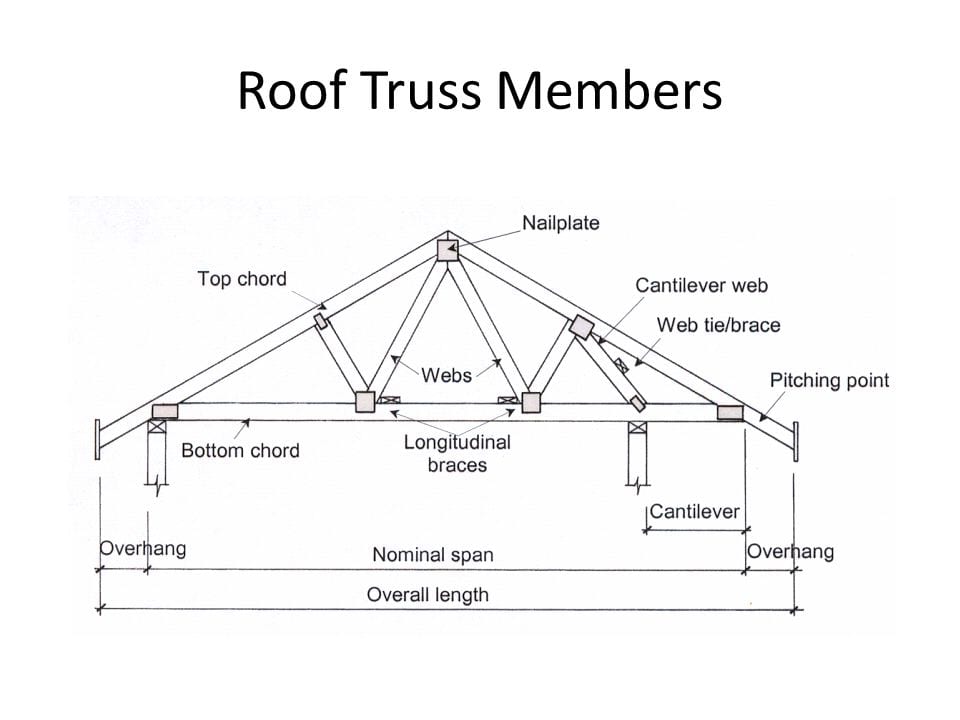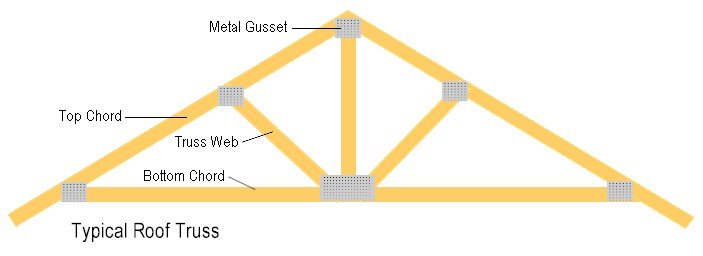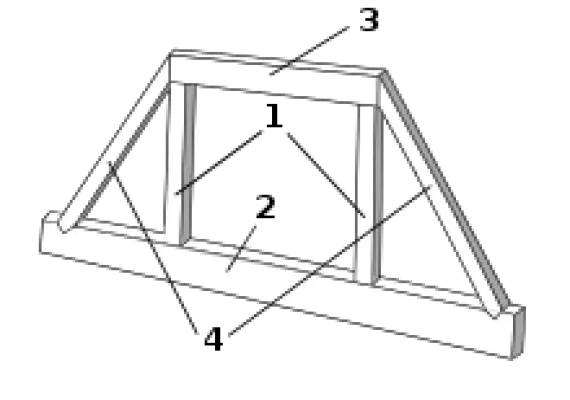What are Trusses | Types of Trusses
What are Trusses | Types of Trusses
What are Trusses
Trusses can define as the triangulation of structure members to make the structure stabilized. Triangulation is the stable structure configuration and typically has a top chord, bottom chord, vertical chord, and diagonal chord members. The main work of the trusses is carrying the loads from the over structures and providing adequate lateral strength to the entire structure.
There are some basic assumptions in the designing process. It should be clarified that the construction of the trusses should conform with the design assumptions to avoid unwanted failures due to the dispersion of the forces and loads.
Types of Trusses
The type of roof truss you choose for your construction project can have a major impact on the final structure. Whether you are building a residential home, apartment projects, or large agricultural structures, roof trusses are crucial elements to the structure, style, and cost of your build. With that in mind, it’s critical to choose the right type of roof truss to suit your project and your project’s budget.
Most common types of roof trusses
Gable Trusses
A variety of the trusses shown above fit into the common or gable truss category, including the King Post, Queen Post, Howe, and Double Howe trusses. All four of these trusses are used to form a gable roof, also known as a pitched or peaked roof. The difference in each of these trusses has to do with the webbing in the truss itself. As you might imagine, trusses like the Howe offer more support than a King Post and thus can be used for larger buildings that need more support.
Hip Truss
Another very common roof type, the hip truss is used to create a hip roof, which has slopes on all four sides that come to meet at a point in the center of the roof. Hip trusses are particularly useful for high wind and snowy areas, as they are more stable than gable roofs. Like the gable truss category, there are several unique hip truss variations, used to create different architectural styles.
Scissor Roof Truss
This type of truss is best known for creating the vaulted ceilings that today’s homeowners love. Instead of horizontal lower chords, a scissor roof truss has lower chords that slope up, creating the peak for a vaulted ceiling. Attic Truss
Attic Truss
Convenient for buildings like garages and sheds that need additional storage space, attic trusses, also known as room-in-attic trusses, form both the ceiling and the floor truss for a room within a building’s attic. These roof trusses come with support webs designed to frame the walls of the room. While these are most commonly used for structures with storage space, they can also be manufactured for homes.
Types of Truss Structures
Trusses are an extremely strong, well-accepted, cost-effective option for the construction of various structures. To maximize the efficiency of the structure (which is often measured in the material used or labor), an appropriate truss type should be selected for the design. Today we will explore what types of trusses are out there and how they can benefit your design.
Truss designs are usually described as either open or closed. A closed truss is a truss with a tie beam, or where the roof structure isn’t visible, such as with a king post truss or a queen post truss. Open trusses, on the other hand, have an interrupted tie beam, which allows for a vaulted ceiling area or where the roof framing is open to view.
Scissor trusses, arch trusses, and hammer trusses are all types of open trusses. To see which truss design is right for your next project, check out the six most popular types of trusses below.
Scissor Truss
A scissor truss sometimes referred to as a vaulted ceiling truss, is a popular style of the wood truss. It is created when two bottom truss beams cross each other, connecting to the angled top beams. The appearance is similar to an opened pair of scissors.
King Post Truss
A king post truss, or turkey track truss, is built with two principal rafters, a tie beam, a central vertical post, and two struts. The central vertical post is what gives the king post truss its triangle shape. For added support, one strut is placed at a 45° angle on each side.
Arch bottom Truss
Think of an arch bottom truss like a king post truss, only taken up a notch. While the overall truss design concept remains the same, the bottom beam is curved, or arched, for a more decorative look.
Multiple King Post Truss
A multiple king post truss is a type of longitudinal truss that can be thought of as a cross between a king post truss and a queen post truss. Installing this type of truss is an easy way to stretch the span capability of a truss. A multiple king post truss features diagonal beams, sometimes referred to as gunstock verticals, for support in between each panel.
These trusses can either be built with an even number of panels so that all the diagonals are in tension and compression. For multiple king post trusses with an odd number of panels, diagonals are opposing (or crossing).
Trusses are the key engineering feature in the emerging civil engineering contest. Indeed, long- Roof trusses, bridges, electricity and telecom towers
Types of Trusses Categories
Simple truss – indicates a single triangular truss. These trusses are most often used as the roof trusses.
Planar truss – as the name implies it is a two-dimensional truss. If all the members and the nodes are on a planar surface, then this truss is planar.
Space frame truss – Contrast to the planar truss, the members and the nodes are located in the three-dimensional space. Electrical and telecom towers are one of the simplest examples that we are seeing in the day to day life.
Proper Roofing Installation and Maintenance
The roof has two functions: One is Insulation and the other is drainage. The insulation protects the house or any structure from the weather effects and also from the noise and intruders.
The roof serves as the drainage of rainwater and the snow this is amassed on the pinnacle of your roof. Gutters are installed to lead rainwater or melted snow toward the floor on the way to not interrupt the airflow of your house.
If gutters aren’t set up, the water might also run down the walls of your own home or building or might also seep into your home or foundation.
The roofing of any house or building varies with climates, use, and style. For commercial buildings, usually have flat roofs due to the fact it is high above the ground, the less difficult, the less expensive. The hip roof is commonly for residential houses; this roof has four slopes, which could be each rectangular and square in shape.
On the other hand, an A-frame roof style is commonly used for churches, cottages, or different types of homes; this type of roof serves as the roof and wall for the entire building. There are so many types of roofs. You can select any of these roof designs for your house, but keep in mind the compatibility of the roof to your property.
Aside from having one-of-a-kind sorts of roofs, the materials used for roofing also varies from the design layout of the roof and the location in which you stay.
Alike other matters, the roof of your house or any structure can also be damaged by way of certain causes like storms, cyclones, heavy rain, etc. If it isn’t always maintained well, you might as properly need to replace roofing materials including clay tiles, asphalt shingles, concrete tile, metallic, slate, wood shingles, or any type of roof that you have, and this could be expensive. We need our roofing system to be properly set up and maintain.
Here are key tips for Proper Roofing Installation and Maintenance
Find the Right Materials
When getting the required materials for your roof, you have to make investments in materials that will last, secure the house from natural impacts like heavy rainfall. It should have an excellent roof framing design as well as maintain the style of the house or construction that is allowed by country building codes.
Installing the Roof Deck Protection
It is important to get high-quality work from a roofing contractor. Roofing is not a DIY time of the task, you’ll need experienced and skilled roof contractors for the proper set up of the roof. The roof deck safety prevents wind-pushed rain from getting into your safe haven.
Installing Leak Barriers
Your roof must have a leak barrier mainly in the edges wherein it’s vulnerable to leakage. This needs to be achieved to mitigate the risks of getting your roof damaged.
Installing Shingles
It is vital to nail your shingles in the proper areas. Installing the first line of your roof shingles need to be completed without an error. It will serve as the base of the other upper shingles which can be mounted later. It should have a strong base to save you from being broken during heavy storms.
Installing Flashing
Flashing is any other material installed to guard the water against seeping into your roof. It is typically positioned on areas where it is at risk of leakages like valleys and vent pipes.
Because of busy schedules, roofing maintenance is often forgotten, but it is crucial to prevent the roof from damages. When it comes to roof maintenance, you need to hire a roofing contractor. You cannot simply climb up on your roof and do the inspection yourself. These expert roof contractors recognize how to do the task in the right way.
They are furnished with safety gears and the right materials to determine where your roof has been damaged. With everyday care and maintenance, you can save more money than watching your roof gets damaged gradually, which can be expensive to repair.



